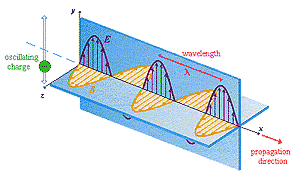3-in-1 Alternative Energy Car DIY STEM Kit
$19.99$12.95
 An electromagnetic wave, as its name implies, consists of alternating electric and
magnetic fields, oriented at 90 degrees to each other, moving at the speed of light.
These
alternating fields sustain themselves because electricity (moving electric charges)
generates a magnetic field, and a changing magnetic field generates an electric field.
An electromagnetic wave, as its name implies, consists of alternating electric and
magnetic fields, oriented at 90 degrees to each other, moving at the speed of light.
These
alternating fields sustain themselves because electricity (moving electric charges)
generates a magnetic field, and a changing magnetic field generates an electric field.
 'Arrows of hate have been shot at me too, but they have never hit me, because somehow they belonged to another world with which I have no connection whatsoever.'
'Arrows of hate have been shot at me too, but they have never hit me, because somehow they belonged to another world with which I have no connection whatsoever.'